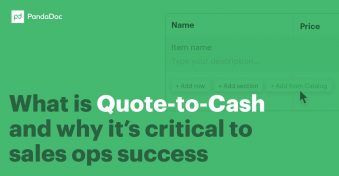CPQ stands for “configure, price, quote,” and is responsible for a very important part of the sales process where the sales team produces quotes for configurable products using specialized software and a great deal of sales automation.
In this article, we’ll talk about every aspect of CPQ and CPQ implementation strategies, explaining why they matter and discussing the software tools you can use to streamline your sales process so that it scales with your business.
Let’s jump in!
01. What does CPQ stand for: An in-depth overview
Once implemented, the CPQ process is deeply embedded into the sales pipeline and the quote-to-cash (Q2C) framework.
To better understand the true meaning and value of CPQ, let’s get acquainted with its three basic parts.
1. Configure
While the majority of products come 100% finalized at the factory and are sold “as is,” there are multiple categories of products that can be configured before checkout to meet the functional and aesthetic needs of customers.
For example, a bike can be sold in a single variation, but some vendors can choose to allow customers or their own sales team to arbitrarily configure multiple aspects of the product, such as:
- Color / paint job / decals
- Gearbox
- Wheel size
- Saddle
- Paddles
- Brakes
- Handlebars
- Mudguards
- Accessories (an air pump, bottle holders, a bike computer, etc.)
In the example above, most of the options are probably mutually compatible.
However, some products may be more complex, and choosing one may prohibit the selection of one or more of the others.
Where CQP comes into play
This is exactly what CPQ addresses.
CPQ solutions provide a convenient admin interface for defining product configuration and pricing rules on the one hand, and a set of customer- or salesperson-facing tools for self-configuration or guided selling on the other.
On top of that, being able to add automation to the quote generation process via CPQ can help enforce compliance, which is especially important for highly regulated industries like banking or healthcare.
Finally, one of the most notable advantages of CPQ solutions is that they substantially lower the technical knowledge threshold for sales personnel.
With CPQ, virtually anyone can sell complex products and save themselves the trouble of having to verify every quote with the product team.
Therefore, the positive effect of using CPQ for configuration purposes manifests itself through minimal sales flow delays, reduced sales cycles, and error-free quotes that are produced automatically with up-to-date, preapproved prices and discount rules.
2. Price
For many sales organizations, setting up basic feature selection will be enough to meet their regular needs.
From the back office, this is typically done using a product catalog.
From within the product catalog, you can set up feature packages, or bundles, for products or services that you sell.
Think of subscription-based services that offer standard, gold, and platinum plans, each including a different set of features and presented at a different price.
For example, PandaDoc offers a dedicated pricing module for this where over 25% of accounts actively use product catalogs, input key information for those items (SKU, Product Name, Price, Description), and combine them into packages that can be easily added to pricing tables in the editor in a fast and easy manner.
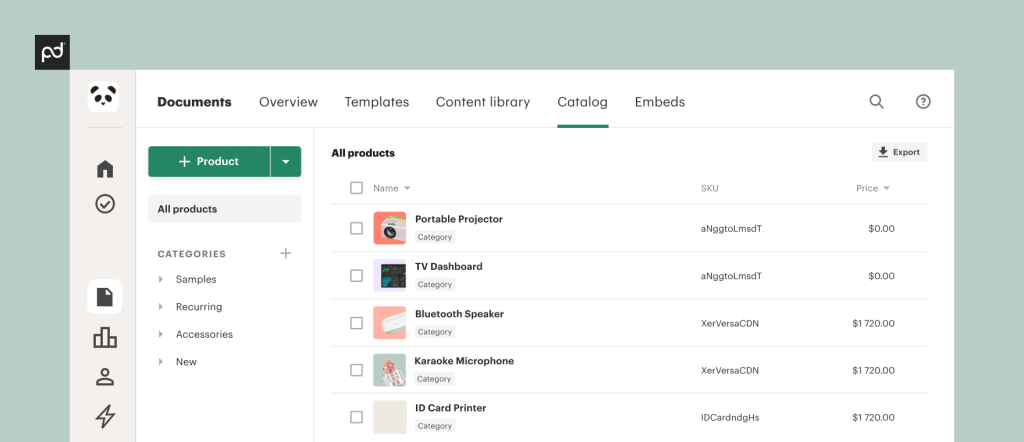
In many situations, customers will be able to switch between those feature bundles in the quote document to find exactly what they need without a sales rep getting involved to update the total cost.
Addressing increased product complexity
However, this approach will likely not work for deeply customizable products with multiple and often dependent components.
Think of a custom PC build or a piece of industrial machinery with dozens or even hundreds of available options.
Such products will require custom pricing for anyone who won’t find a suitable configuration among the predefined ones.
In this case, sales reps will no longer be able to rely on product catalogs and preconfigured bundles alone.
This level of customization requires much more advanced and specialized CPQ solutions for creating accurate sales quotes.
These solutions typically come from third-party vendors and are integrated with CRM/ERP systems that are used as a source of accurate pricing and product availability data.
They also feature powerful tools for defining complex product configuration, upsell, and discount calculation rules.
3. Quote
Once the configuration part of the quoting process is over, the sales person puts together a quote document and sends it out as quickly as possible.
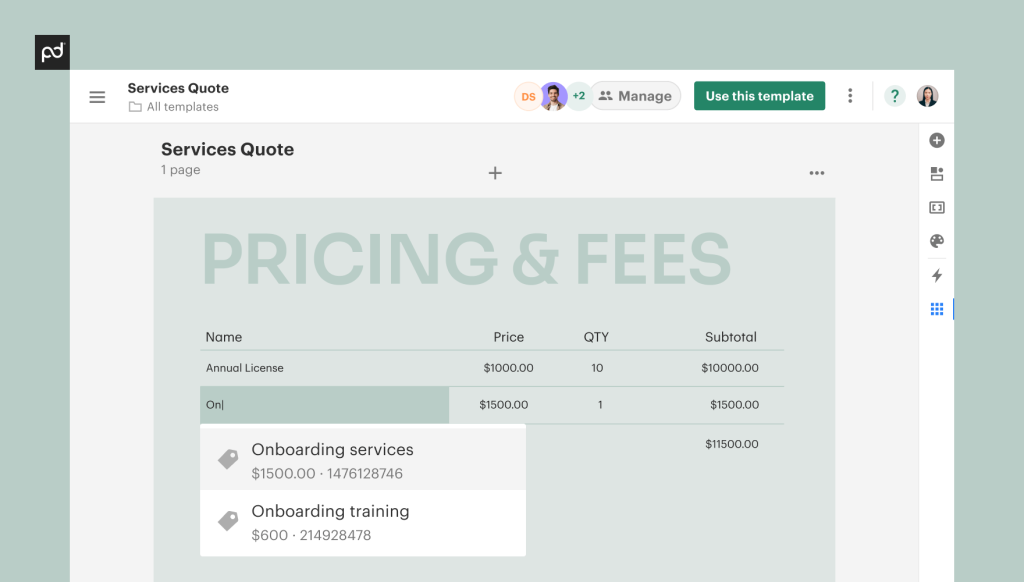
And while that may seem pretty straightforward, the quoting process can become very complex.
Due to the fact that product configuration can involve multiple variables, it is not uncommon for sales reps to occasionally overlook minor inconsistencies, quote inaccurate numbers, or forget about proper document formatting — which may result in poor customer experience or even lost deals.
A CPQ platform can help nip these issues in the bud before they have any effect on business — and assist you in creating professional-looking quotes that include all the necessary legal and industry-specific terms, enhancing trust and reducing turnaround times.
A few examples of CPQ in action
Using the product catalog from the previous section, reps building quotes with PandaDoc would simply add predefined line items to the pricing table.
All of the pricing and related inventory would be added to the quote automatically.
Finally, if you are using a more advanced solution such as native Salesforce CPQ or Salesforce integrated with a third-party CPQ product, product configurations would be created with corresponding tools and be based on up-to-date, verified, pre-approved product and pricing data coming directly from the corporate CRM or ERP system.
In this case, PandaDoc can integrate with your CRM to serve as a power-packed proposal management solution that fully covers the quote-to-cash cycle and addresses the challenge of providing customers with beautiful, professional, detailed documents that are a breeze to create and track.
Many companies also have internal business processes to act as safeguards against flawed quotes and proposals, including internal reviews and approval workflows that must be completed to confirm the document’s validity.
Unfortunately, these processes are time-consuming and add to the duration of the sales cycle, which can be a major disadvantage if you’re operating in a competitive market where a competitor can take advantage of your slow response time.
Sales teams can automate processes and speed up deals from the quoting stage to payment.
02. Benefits of CPQ software
A late 2022 report by Salesforce, one of the leading CRM vendors in the market, revealed that salespeople often spend less than 30% of their time actually selling products.
At the very least, here is what CPQ is likely to bring to the table for you and your team:
- Outstanding buyer experience
- Ease of staff onboarding
- Lower technical requirements for sales personnel
- Reduced sales overhead
- Error-free quotes
- Reduced sales workflow delays and shorter sales cycles
- Instant price and product/part availability verification
- Automatic rule-based discount calculation
- Automatic upsell/cross-sell suggestions to increase the average deal size
- Instant quote document generation in the necessary format
However, in order to achieve all of the above, you’ll need to find the right CPQ solution that can help your team succeed.
03. What is the CPQ process
The CPQ process is a way of approaching the sales of products or services whereby you customize the offering to the individual customer’s needs through automation on either the sales rep’s or the customer’s side.
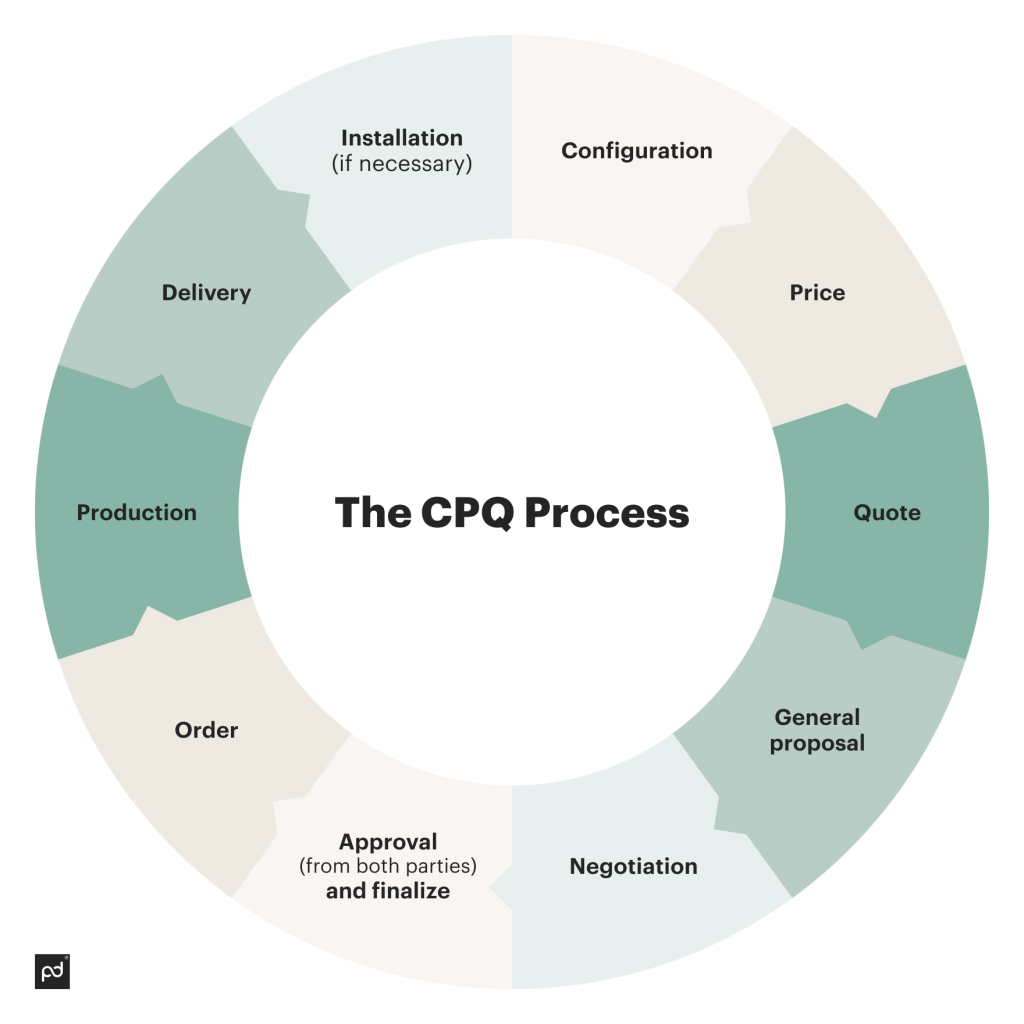
Since CPQ is part of a wider Quote-to-Cash (Q2C) process framework, it only includes the steps that directly pertain to generating quotes based on unique requirements:
- Configuration
- Price
- Quote
You also need to generate a compelling proposal, collaborate with your prospect to reach agreement, deliver on your commercial promise, and collect your money, but these steps are beyond the scope of CPQ.
Each of these steps can be further streamlined to better meet the needs of particular industries.
For example, manufacturers of sophisticated industrial equipment may want to heavily customize their CPQ solution and integrate it with a product information system and ERP to cover as much of their process as possible.
04. Advantages that come with CPQ software
So far, we’ve talked about the CPQ process and how CPQ tools can help you address your key sales pain points, but the benefits don’t stop there.
As a sales tool, CPQ systems can have a major impact on the sales workflow and customer relationship management.
A properly configured CPQ software tool can deliver numerous advantages that help level up your team’s entire approach to sales:
Streamlined operations
The use of CPQ tools enables more of your sales personnel to sell products that previously required profound technical expertise or verification with technical specialists.
Onboarding of new sales reps becomes considerably easier thanks to the reduced length of product training and automation of the sales process.
Error reduction
Quoting automation ensures the veracity of every quote, as product data is pulled directly from a product catalog or the company’s ERP system.
Multiple checks and rules applied in real time during the product configuration process take care of compatibility issues for standard parts and accessories.
Enhanced customer experience
CPQ dramatically reduces the time required for sales reps to prepare complex quotes and even enables customers to configure their order on their own if the CPQ solution is integrated with the front-end part of your online store.
Good-looking, detailed quotes that automatically answer your customers’ questions are the fastest lane to acceptance and winning new business.
At PandaDoc, our customers see incredible results in terms of document creation time, close rate, and the number of documents that reps generate every month.
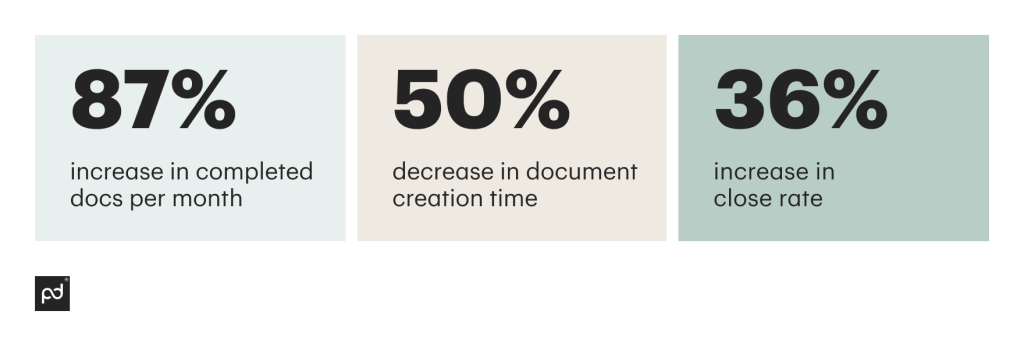
On top of that, CPQ tools typically provide valuable insights into the most winning product configurations, which allows you to flexibly adjust your standard product offerings for higher sales numbers and profit.
05. Example scenarios where CPQ is needed
It goes without saying that CPQ is perfect for selling configurable products of any type.
However, there are some unusual scenarios where you may also consider CPQ for improving your business’s processes:
Complex agreements in law firms
CPQ can be used for services as well as products.
Legal services are complex by nature and always require very extensive, precise definitions that may get altered beyond recognition after a series of edits.
A CPQ tool can help combine and manage various terms and conditions in legal services proposals and agreements, ensuring accuracy and compliance across the board through advanced document automation.
In plain English, you can use CPQ to compile a list of predefined and accurately described services instead of writing definitions from scratch time after time or copying them from an existing document where they may have been customized for a particular client/case.
Custom IT services
Sales teams at software development and SaaS companies can use CPQ to quickly put together comprehensive quotes and proposals for custom services and development projects.
Standard blocks, service descriptions, and rates that form the skeleton of every proposal can be added to a document in seconds and then polished for specific project/client requirements.
Healthcare equipment/software sales
Intrinsically complex and subject to various compliance regulations, selling healthcare equipment and specialized software can benefit greatly from CPQ.
Enabling sales personnel to confidently configure medical hardware/software packages and save time on validation and approvals can provide a solid boost to conversion rates and help streamline how your business generates sales quotes.
For example, Interlace Health, an established supplier of software for hospitals and healthcare institutions, was able to cut down the proposal creation time by as much as 85% thanks to the use of PandaDoc and its advanced features like catalogs and pricing tables.
No matter your line of business you are in, CPQ software will help you build an efficient quote generation pipeline that relies on pre-approved templates and prices, convenient methods of routing quotes to relevant team members for approval, and then forwarding them to customers — often using electronic signature software for closing deals on the spot.
06. Implementing CPQ
Now that we’ve talked about the CPQ process, CPQ software solutions, and the reasons why you may want to implement these tools and make them part of your standard workflow, let’s get into the specifics of how to take the next steps.
Step 1. Assessment
Any CPQ software that you may consider will need to coexist with other solutions you use to manage your business on a daily basis.
On top of that, your primary task with CPQ implementation is to tackle existing inefficiencies.
Therefore, if you are already using an ERP, CRM, or document management platform, compatibility and native integration with those systems becomes one of the key criteria for choosing a CPQ solution.
Some CPQ solutions may be more focused on being an all-in-one tool that captures all customer data, while tools like PandaDoc can offer native integrations for popular CRM and accounting platforms.
Step 2. Selection
Once you have your business pains written down, contact the vendors that you’ve shortlisted so far and ask them to demonstrate how their software can resolve these issues.
Request a demo and let them walk you through their product in a sandbox environment.
When shortlisting CPQ candidates, whenever possible, make sure to check out their list of clients.
For example, if you are an SMB, it would be great to find out that most of their clients represent the same type and size of business.
Keep in mind that the opposite is also true — if you are a large manufacturing enterprise, you would not want to find out that your growth may be hampered by the limitations of an SMB-oriented solution.
Step 3. Customization
Even the best CPQ software does not work perfectly “out of the box,” so get ready to invest some time and effort into populating up your product catalog, configuring specific products, setting product- or category-specific discount rules, as well as other important parameters.
Some CPQ products even allow you to use scripting to implement more complex price calculation and product configuration scenarios.
Step 4. Training
Your sales team will not be efficient without proper familiarization with their new tools.
Make sure everybody in your company understands the value of CPQ technology and knows how to use it to boost their performance.
The onboarding stage is also a great time to collect initial feedback and implement the necessary changes before the launch of the system.
Finally, keep in mind that effective CPQ implementation doesn’t stop once the first quote goes out.
Set periodic checks for CPQ performance assessments and gauge your sales performance regularly to get even better results.
Help your sales team adopt CPQ with ease
Now that you’re familiar with CPQ technology 101, it may be a good time to try one of the better-known CPQ products without making major investments or commercial commitments.
With PandaDoc, you’ll get native integrations with major CRMs, as well as key payment gateways like Stripe, Square, and PayPal.
Our platform also comes with secure eSigning capabilities and a state-of-the-art document management system for all of your quoting and proposal generation needs.
To learn more with the help of our experts, start a 14-days trial today.
Frequently asked questions about CPQ
-
CPQ can be implemented as part of a CRM (Customer Relationship Management) system, and some software solutions deliver this.
Having CPQ as part of wider CRM is a natural route to take, as many CPQ conversations are informed by CRM data.
Merging a CRM platform that manages data and customer interactions with a CPQ tool that supports sales teams streamlines processes and helps you keep all information in one place.
-
Choosing between the CPQ tools on the market today is about what your business needs.
Some tools, like PandaDoc, use onboard document editors and templating options for fast and easy quoting. Other tools, like Quotewerks, rely heavily on the power of a product database.
-
As with all automation tools, CPQ software can help you build a reliable system that you can use to create standardized pricing and keep everyone on the same page. While it can help you improve your sales workflow and quoting process in those ways, though, it won’t be able to help if you lack an understanding of what products you want to sell and how they need to be configured.
-
For the most part, yes. Most configure, price, quote software is industry agnostic.
For most CPQ tools, it won’t matter what products or services you add to the database. The tools and functionality of the software tool will work the same for every business and in nearly every scenario.
-
Not every CPQ tool will help you collect payments.
Some CPQ tools, like PandaDoc, come equipped with a payment gateway so that you can quote and bill at the same time.
On the other hand, Salesforce CPQ relies on Salesforce Billing — a completely separate module within the Salesforce platform — to handle payments and invoicing. Other CPQ systems may have no payment gateway functionality.
-
In a nutshell, customer relationship management (CRM) software handles customer profiles and keeps track of any customer orders and correspondence.
CPQ systems help you build and quote orders for customers that exist within your CRM database.
If you don’t already use a CRM platform, some CPQ tools may provide support or integrations with CRM solutions. PandaDoc, for instance, integrates with Salesforce and other platforms.
The Salesforce CPQ integration is one of the most popular because this powerful combination completely eliminates copying and pasting customer data into important sales documents. This means that your teams can consistently and rapidly produce quality collateral.
Users love the real-time document status updates delivered via the Salesforce dashboard that easily determine when prospects are interacting with received documents.
Because PandaDoc integrates with all Salesforce Sales Cloud editions, your business can effortlessly switch from Salesforce Classic to Lightning without losing any data in the process.
Disclaimer
PandaDoc is not a law firm, or a substitute for an attorney or law firm. This page is not intended to and does not provide legal advice. Should you have legal questions on the validity of e-signatures or digital signatures and the enforceability thereof, please consult with an attorney or law firm. Use of PandaDocs services are governed by our Terms of Use and Privacy Policy.
Originally published February 21, 2018, updated April 23, 2024


